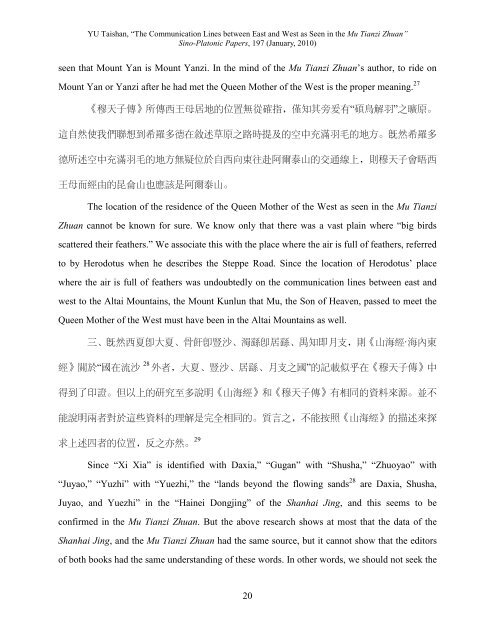Mu Tianzi Zhuan - Sino-Platonic Papers
Mu Tianzi Zhuan - Sino-Platonic Papers
Mu Tianzi Zhuan - Sino-Platonic Papers
Create successful ePaper yourself
Turn your PDF publications into a flip-book with our unique Google optimized e-Paper software.
YU Taishan, “The Communication Lines between East and West as Seen in the <strong>Mu</strong> <strong>Tianzi</strong> <strong>Zhuan</strong>”<br />
<strong>Sino</strong>-<strong>Platonic</strong> <strong>Papers</strong>, 197 (January, 2010)<br />
seen that Mount Yan is Mount Yanzi. In the mind of the <strong>Mu</strong> <strong>Tianzi</strong> <strong>Zhuan</strong>’s author, to ride on<br />
Mount Yan or Yanzi after he had met the Queen Mother of the West is the proper meaning. 27<br />
《穆天子傳》所傳西王母居地的位置無從確指,僅知其旁爰有“碩鳥解羽”之曠原。<br />
這自然使我們聯想到希羅多德在敘述草原之路時提及的空中充滿羽毛的地方。旣然希羅多<br />
德所述空中充滿羽毛的地方無疑位於自西向東往赴阿爾泰山的交通線上,則穆天子會晤西<br />
王母而經由的昆侖山也應該是阿爾泰山。<br />
The location of the residence of the Queen Mother of the West as seen in the <strong>Mu</strong> <strong>Tianzi</strong><br />
<strong>Zhuan</strong> cannot be known for sure. We know only that there was a vast plain where “big birds<br />
scattered their feathers.” We associate this with the place where the air is full of feathers, referred<br />
to by Herodotus when he describes the Steppe Road. Since the location of Herodotus’ place<br />
where the air is full of feathers was undoubtedly on the communication lines between east and<br />
west to the Altai Mountains, the Mount Kunlun that <strong>Mu</strong>, the Son of Heaven, passed to meet the<br />
Queen Mother of the West must have been in the Altai Mountains as well.<br />
三、旣然西夏卽大夏、骨飦卽豎沙、濁繇卽居繇、禺知即月支,則《山海經·海內東<br />
經》關於“國在流沙 28 外者,大夏、豎沙、居繇、月支之國”的記載似乎在《穆天子傳》中<br />
得到了印證。但以上的研究至多說明《山海經》和《穆天子傳》有相同的資料來源。並不<br />
能說明兩者對於這些資料的理解是完全相同的。質言之,不能按照《山海經》的描述來探<br />
求上述四者的位置,反之亦然。 29<br />
Since “Xi Xia” is identified with Daxia,” “Gugan” with “Shusha,” “Zhuoyao” with<br />
“Juyao,” “Yuzhi” with “Yuezhi,” the “lands beyond the flowing sands 28 are Daxia, Shusha,<br />
Juyao, and Yuezhi” in the “Hainei Dongjing” of the Shanhai Jing, and this seems to be<br />
confirmed in the <strong>Mu</strong> <strong>Tianzi</strong> <strong>Zhuan</strong>. But the above research shows at most that the data of the<br />
Shanhai Jing, and the <strong>Mu</strong> <strong>Tianzi</strong> <strong>Zhuan</strong> had the same source, but it cannot show that the editors<br />
of both books had the same understanding of these words. In other words, we should not seek the<br />
20
















